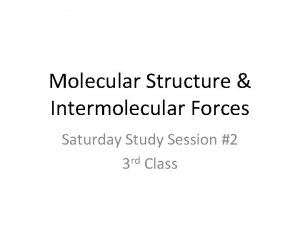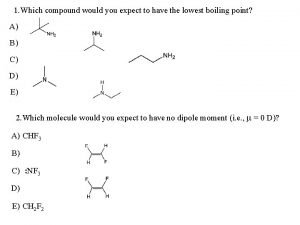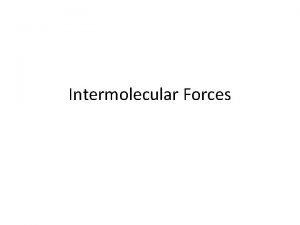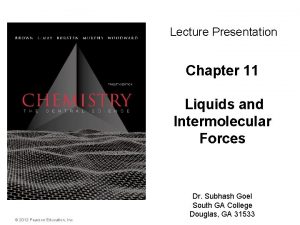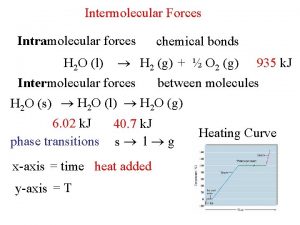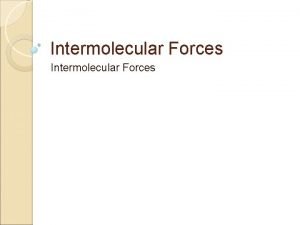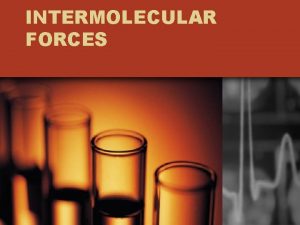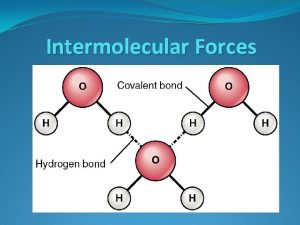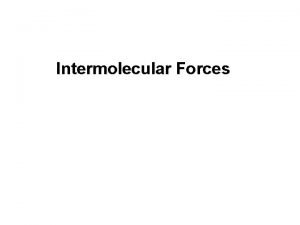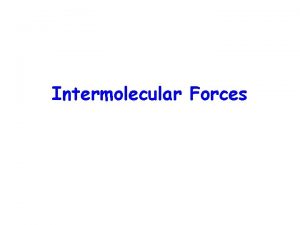8 11 NOTES Attractive Intermolecular Forces Attractive Intermolecular










- Slides: 10

8. 11 – NOTES Attractive (Intermolecular) Forces

• Attractive (Intermolecular) Forces: forces that exist between molecules that contribute to the properties of the substance. • Intramolecular vs. Intermolecular • Intramolecular Forces: Forces of Attraction within the molecule. • Examples: covalent, ionic, and metallic bonds. • Intermolecular Forces: Forces of Attraction in between molecules • Also called Van der Waals Forces. • Examples: London Dispersion, Dipole-Dipole, and Hydrogen Bonding. • Intramolecular Forces are stronger than Intermolecular Forces.

• London Dispersion Forces (LDFs) • Weakest IMF • Occur between nonpolar covalent molecules • Due to Temporary (Instantaneous) Dipoles: as electrons orbit the nucleus of two adjacent atoms, there are often instances where the electrons are in uneven distribution, which creates temporary charges. • LDFs become stronger when the number of electrons increases • F 2 Cl 2 Br 2 I 2


• Dipole-Dipole Forces • Stronger than LDFs • Occur due to Permanent Dipoles which are found in all polar covalent molecules. • How is this determined? Polar Bonds and Polar Molecules • The higher the electronegativity difference, the stronger the dipole-dipole interaction.

• Hydrogen Bonding • Strongest IMF • A special type of dipole-dipole force • Occur in polar covalent molecules when the EN difference is very large, and the atoms are very small. • Hydrogen must be bonded to either Fluorine, Oxygen, or Nitrogen. • Chlorine is too big!

• Do these molecules exhibit Hydrogen Bonding? • HF NH 3 CH 3 F CH 3 OH

• Properties of Covalent (Molecular) Substances • Molecular Substances vary in state at room temperature • Many are solid: sugars, rubber, wax, I 2 • Some are liquid: water, alcohols, some fuels (octane), Br 2 • Most are gases: CO 2, SO 2, CO, Cl 2, F 2 • Regardless of state, molecular substances have low MPs and BPs. • Most are insoluble in water • Polar Solutes can dissolve in polar solvents (H 2 O) • Nonpolar Solutes can dissolve in nonpolar solvents (Hexane, CCl 4, etc. ) • Most are non-conductors and relatively soft • Some polar molecules conduct when dissolved in water (i. e. acids and bases)


• Compare ionic and covalent compounds: • Ionic Covalent • - mostly solid - S, L, G (solid state forms a lattice similar to ionics but with less strength); G = O 2, H 2 S, CO 2 • - high MP/BP - low MP, BP • - water soluble - solubility varies greatly in water • - conducts electricity - poor conductors • - hard - relatively soft (paraffin) • -vaporize readily at room temperature
 δ+
δ+ Intramolecular forces vs intermolecular forces
Intramolecular forces vs intermolecular forces Intramolecular forces vs intermolecular
Intramolecular forces vs intermolecular No structure
No structure Attractive forces
Attractive forces Intermolecular forces of attraction
Intermolecular forces of attraction Strongest to weakest intermolecular forces
Strongest to weakest intermolecular forces Capillary action
Capillary action Strength of intermolecular forces
Strength of intermolecular forces Surface tension intermolecular forces
Surface tension intermolecular forces Intramolecular vs intermolecular forces
Intramolecular vs intermolecular forces



